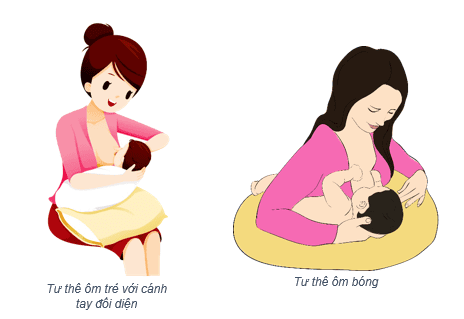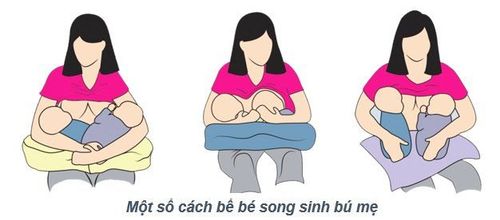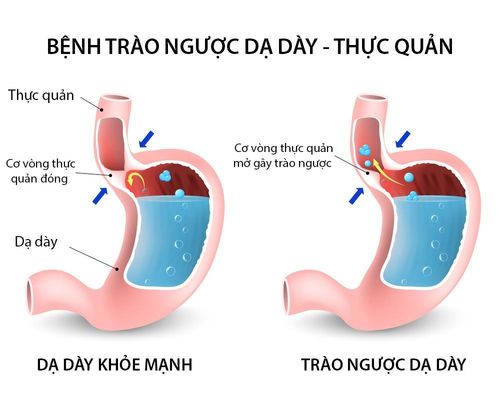This is an automatically translated article.
The article was professionally consulted by Specialist Doctor I Truong Nghia Binh - Obstetrician-Gynecologist - Department of Obstetrics and Gynecology - Vinmec Da Nang International General Hospital.
Breastfeeding properly is not a simple matter especially for first time mothers. So what are the correct breastfeeding positions, so that the baby can suckle a lot of milk without choking and the mother is also comfortable and feels rested.
1. Correct breastfeeding positions
1.1 Sitting position Each feeding can last up to 30 minutes, so mothers should choose a seat with comfortable support on the bed or chair. The most common and easiest position is the mother holding the baby lying in her lap, her arms forming a solid arc.Feed the baby on any breast, use the hand on the same side of that breast to support the baby. Ensure three points: The baby's head - back - bottom is in a straight line and the baby lies on his side facing the mother's breast so that the baby's belly touches the mother's belly, the baby's face touches the mother's chest.
Note: a common mistake is that the mother puts the baby in the supine position and only the head is tilted towards the mother's chest, this will make the baby feel uncomfortable while breastfeeding and not good for the baby's neck. .
In addition, there are some other ways to hold the baby to breastfeed in a sitting position such as:

Trắc nghiệm: Vì sao mẹ sinh mổ xong khó có sữa ngay?
Vì sao mẹ sinh mổ xong khó có sữa ngay là thắc mắc và lo lắng chung của nhiều sản phụ. Bài trắc nghiệm này sẽ giúp sản phụ giải đáp thắc mắc cũng như tìm hiểu được phương pháp gọi sữa về sau sinh mổ.The following content is prepared under supervision of Thạc sĩ, Bác sĩ y khoa, Tạ Quốc Bản , Sản phụ khoa , Khoa Sản phụ khoa - Bệnh viện Đa khoa Quốc tế Vinmec Phú Quốc
1.2. Lying position If the mother is not strong enough to sit, she can lie on the bed and let the baby lie on her side to feed. However, mothers should practice sitting up and walking soon after giving birth to help blood circulation, help recover health and soon breastfeed the baby in a sitting position.
This is the position that a lot of moms do because the baby will get a lot of milk in this position. When breastfeeding in this position, the mother lies on her side parallel to the baby, then puts the baby close to her body, then holds the baby's head with her hand and gradually turns the baby's head to her breast to suck.
This is the most relaxing and comfortable position for the mother, so it is easy for the mother to fall asleep and so is the baby. If the mother falls asleep without taking the nipple out of the baby's mouth, the nipple may press on the baby's nose, leading to a very dangerous suffocation. Therefore, when performing this position, the mother must always be awake to observe the baby, ensure it is safe to breastfeed, and sleep only when the breast is withdrawn from the baby's mouth.

Put the two babies parallel to the mother's sides, the baby's legs are behind the mother's back, the baby's head is facing forward and the face is pressed against the mother's nipple.
To avoid hand fatigue from supporting the baby, you can use a towel or a U-shaped pillow underneath. But do not put the baby to rest on the pillow completely because the baby will not be able to suckle.
One by one, when one is stable, continue with the other.
Despite having twins, one baby sucks weaker, the baby sucks stronger. The baby who is weaker in latching on to the mother's breast should suckle first, after this baby is stabilized, let the baby suckle more strongly.
Change the back and forth position for two babies so that the amount of milk secreted evenly, the nipple is not disparate and protects the baby's eyes to work in balance.

2. Tips to make breastfeeding effective
2.1. Learn to recognize your baby's hunger signals When hungry, your baby becomes more alert and active. The baby can put his whole hand in his mouth to suck or turn his head to look for the mother's breast. When he sees anything - for example, the mother's arm touches his cheek, the baby may turn towards it, ready to suckle. This move is called the seeking reflex.Feed your baby when you see this sign. Waiting until the baby cries to feed may be too late, moreover, when the baby is upset, it becomes more difficult to properly latch on to the breast. The later, the mother will be more sensitive and can quickly recognize the baby's hunger signals to feed in time.
2.2 Follow the baby's instructions After choosing a comfortable sitting position for mother and baby, the baby has latched on properly, the mother should follow the baby's instructions, Some babies need to feed from both sides in each feeding. keep sucking, others find satisfaction immediately after sucking on one side. As long as the baby sucks and swallows, the mother should help the baby drain the first milk, so that the baby will receive the full fat milk at the end of the feeding.
Usually the baby will release the breast on its own when it is full and can fall asleep. If your baby has finished feeding on one side but still not enough, you can switch to the other side.
2.3.Holding the baby close to the mother The baby is still quite unfamiliar with the new world and needs to be hugged very close to the mother. Skin-to-skin contact helps babies cry less, and their heart rate and breathing are more regular.
2.4.Avoid using a pacifier for the first few weeks During the first few weeks after birth, parents should avoid giving their baby pacifiers, bottles, and formula supplements, unless directed by a doctor. If additional milk is needed, expressed breast milk should be used first, but it is still best to feed the baby directly as this helps the mother's body to produce milk and prevents the baby from being confused between a pacifier and a real one during this time. time to start learning to breastfeed.
2.5. Know when to wake your baby In the first weeks after birth, you need to wake your baby if it's been more than 4 hours since the start of the last feeding. Mothers can apply a few ways to wake up the baby: changing diapers, giving the baby skin-to-skin contact with you, massaging the baby's back, belly and legs. If your baby often falls asleep while nursing, you need to closely monitor his weight and check that the baby is latching on to the breast correctly.
Breast milk is the best and necessary food for babies when they are born, breastfeeding is beneficial for both mother and baby. Babies need to be fed colostrum, within the first hour after birth. Babies need to be exclusively breastfed for the first 6 months and continue to breastfeed until 24 months.
Please dial HOTLINE for more information or register for an appointment HERE. Download MyVinmec app to make appointments faster and to manage your bookings easily.















